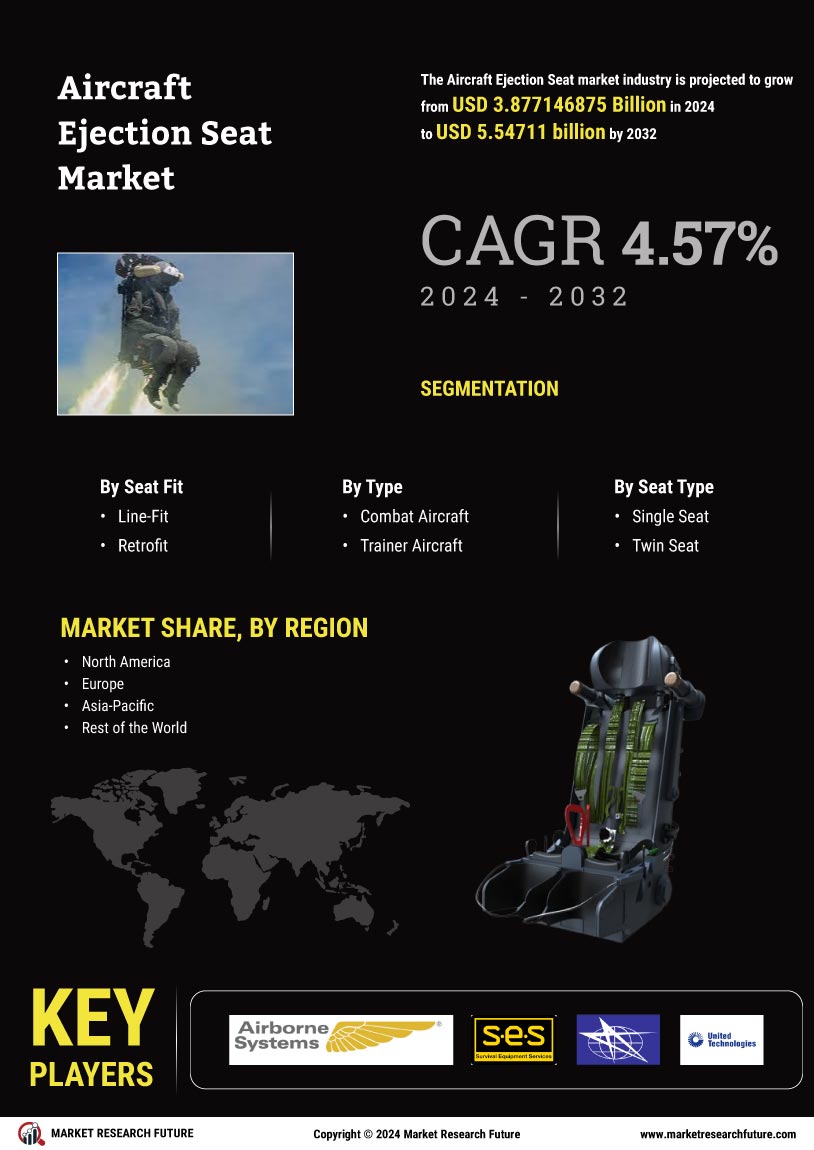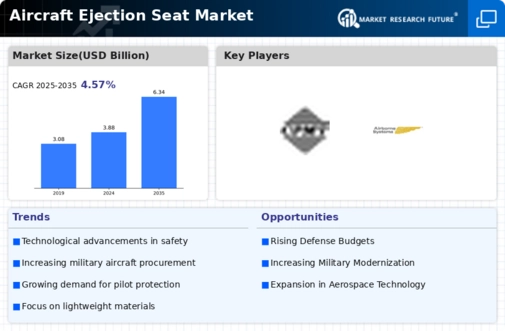Market Trends and Projections
The Global Aircraft Ejection Seat Industry is characterized by various trends and projections that indicate its future trajectory. The market is anticipated to grow from a value of 3.88 USD Billion in 2024 to an estimated 6.34 USD Billion by 2035, reflecting a compound annual growth rate of 4.58% from 2025 to 2035. This growth is driven by factors such as increasing military expenditure, technological advancements, and the rising demand for safety in aviation. The market dynamics suggest a robust future for ejection seat manufacturers as they adapt to evolving industry needs and regulatory requirements.
Increasing Military Expenditure
The Global Aircraft Ejection Seat Industry is poised to benefit from the rising military expenditure across various nations. Governments are increasingly investing in advanced defense technologies, which includes the development and procurement of modern aircraft equipped with sophisticated ejection seats. For instance, the United States and several NATO countries have allocated substantial budgets for upgrading their air forces, which directly influences the demand for innovative ejection seat systems. This trend is expected to contribute to the market's growth, with projections indicating a market value of 3.88 USD Billion in 2024, reflecting the heightened focus on pilot safety and operational efficiency.
Growing Demand for Commercial Aviation
The Global Aircraft Ejection Seat Industry is experiencing growth driven by the increasing demand for commercial aviation. As airlines expand their fleets and introduce new aircraft models, the need for enhanced safety features, including ejection seats, becomes paramount. This trend is particularly evident in regions with burgeoning air travel markets, such as Asia-Pacific and the Middle East. The integration of ejection seats in commercial aircraft, although less common than in military applications, is gaining traction as safety regulations become more stringent. This growing demand is expected to contribute to the market's expansion, with projections indicating a market value of 6.34 USD Billion by 2035.
Regulatory Standards and Safety Protocols
The Global Aircraft Ejection Seat Industry is significantly influenced by stringent regulatory standards and safety protocols established by aviation authorities. Organizations such as the Federal Aviation Administration (FAA) and the European Union Aviation Safety Agency (EASA) impose rigorous safety requirements for aircraft, including the implementation of effective ejection seat systems. Compliance with these regulations not only ensures pilot safety but also enhances the overall operational reliability of aircraft. As regulatory frameworks continue to evolve, manufacturers are compelled to innovate and improve their ejection seat technologies, thereby driving market growth and ensuring adherence to international safety standards.
Emerging Markets and Defense Modernization
Emerging markets are increasingly modernizing their defense capabilities, which is a key driver for the Global Aircraft Ejection Seat Industry. Countries in regions such as Asia-Pacific, Latin America, and the Middle East are investing in upgrading their military fleets, including the acquisition of advanced aircraft equipped with state-of-the-art ejection seats. This modernization effort is often accompanied by collaborations with established defense contractors, facilitating the transfer of technology and expertise. As these nations enhance their defense infrastructure, the demand for reliable and efficient ejection seat systems is expected to rise, contributing to the overall growth of the market.
Technological Advancements in Ejection Seats
Technological advancements play a pivotal role in shaping the Global Aircraft Ejection Seat Industry. Innovations such as zero-zero ejection seats, which allow pilots to safely eject at zero altitude and zero speed, are becoming increasingly prevalent. These advancements enhance pilot safety and operational capabilities, making them attractive to military and civilian aircraft manufacturers alike. The integration of advanced materials and smart technologies into ejection seat designs is also noteworthy. As these technologies continue to evolve, they are expected to drive market growth, with a projected CAGR of 4.58% from 2025 to 2035, indicating a robust future for the industry.













